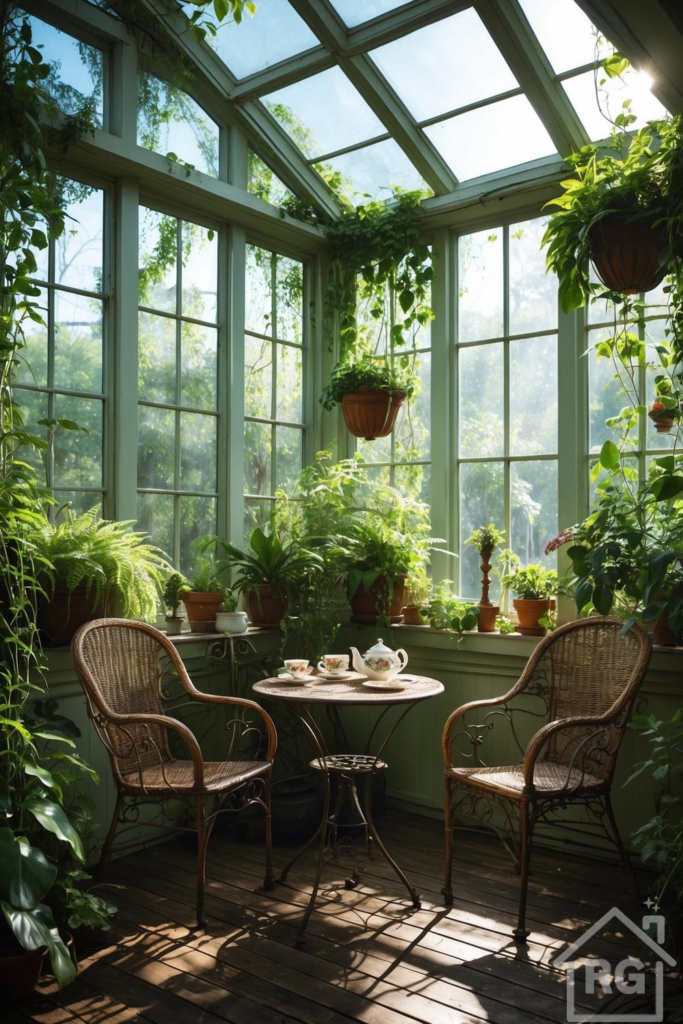
Bring the Outdoors In: The Magic of a Sunroom Garden
Imagine stepping into a space bathed in natural light, surrounded by vibrant greenery, where you can enjoy a quiet cup of tea regardless of the weather outside. This dream can be a reality with a well-designed sunroom or conservatory, like the tranquil oasis pictured. These versatile spaces bridge the gap between indoors and outdoors, offering a perfect environment for both relaxation and plant cultivation. Whether you call it a sunroom, conservatory, solarium, or garden room, the goal is the same: to create a bright, airy extension of your home filled with life.
Why Create a Sunroom Garden?
- Year-Round Greenery: Enjoy the beauty and benefits of plants throughout the year, protected from harsh weather conditions.
- Natural Light Boost: The abundance of glass maximizes sunlight exposure, which is not only great for plants but also beneficial for human well-being, potentially boosting mood and productivity.
- Versatile Space: A sunroom can serve multiple purposes – a reading nook, a breakfast spot, a home office, an entertainment area, or simply a peaceful retreat.
- Increased Home Value: A well-designed and maintained sunroom can be an attractive feature for potential homebuyers.
Designing Your Sun-Drenched Sanctuary: Key Elements
Creating a space as inviting as the one shown involves careful consideration of several elements, from plant selection to furniture choices.
1. Maximizing Light and Structure
The defining feature of a sunroom is its windows. Large, expansive glass panels, often including a glass roof or skylights as seen in the image, are crucial for flooding the space with sunlight. The structure itself, often painted in light, reflective colors like the soft sage green here, enhances the airy feel. Consider the orientation of your sunroom – south-facing rooms receive the most intense light, while north-facing rooms offer softer, more consistent illumination.
2. Plant Selection and Arrangement
Choosing the right plants is key to a thriving sunroom garden. Consider the amount of light your specific room receives.
- High-Light Lovers: For bright, sunny spots, consider succulents, cacti, hibiscus, bougainvillea, or citrus trees.
- Medium to Bright Indirect Light: Many popular houseplants thrive here, including ferns (like the Boston ferns shown), spider plants, peace lilies, ficus trees, and various vining plants (Pothos, Philodendron) which look wonderful cascading from hanging baskets or shelves.
- Lower Light Corners: Even sunrooms have shadier spots. Snake plants, ZZ plants, and some ferns can tolerate lower light conditions.
Think vertically! Utilize hanging planters, shelves, and plant stands to create layers of greenery, drawing the eye upward and making the most of the space. Group plants with similar light and water needs together. The image showcases a beautiful mix of floor plants, tabletop pots, windowsill arrangements, and hanging baskets, creating a lush, immersive feel.
3. Furniture and Functionality
Choose furniture that complements the natural setting and withstands potential humidity and sunlight exposure. Natural materials are often a perfect fit:
- Wicker and Rattan: As seen with the charming bistro set in the image, wicker and rattan offer a classic, airy look that blends seamlessly with garden environments. They are lightweight and relatively durable.
- Metal: Wrought iron or aluminum furniture, like the base of the table and chairs pictured, adds a touch of elegance and durability.
- Wood: Teak or cedar are naturally resistant to moisture and decay, making them suitable choices, though they may require occasional maintenance. The wooden floor adds warmth and texture.
Consider the primary function of your sunroom. If it’s for dining or morning coffee, a bistro set like the one shown is ideal. For lounging, comfortable armchairs or a small sofa with outdoor-friendly cushions might be better. Ensure pathways are clear for easy movement and plant care.
4. Flooring and Finishes
Sunroom flooring needs to be durable and water-resistant. Tile, stone, concrete, or durable wood flooring (like the warm wood planks in the image) are excellent choices. They are easy to clean if soil or water spills. Area rugs can add softness and define zones, but choose materials suitable for potentially higher humidity and light exposure (e.g., indoor/outdoor rugs).
5. Accessories and Ambiance
Accessorize thoughtfully to enhance the garden feel. Terracotta pots, ceramic planters in various colors and styles, watering cans, and small garden tools can add character. Soft lighting for the evenings, perhaps string lights or lanterns, can extend the usability of the space. The simple, elegant tea set in the image adds a touch of refinement and purpose to the bistro setting.
Maintaining Your Indoor Oasis
A sunroom garden requires regular care:
- Watering: Plants in sunrooms may dry out faster due to increased light and warmth. Check soil moisture regularly.
- Ventilation: Ensure good air circulation to prevent stagnant air and reduce the risk of pests and diseases. Open windows or use fans if necessary.
- Pest Control: Inspect plants regularly for common houseplant pests like spider mites or aphids.
- Cleaning: Keep windows clean inside and out to maximize light penetration. Regularly dust leaves and clean floors.
- Temperature Control: Sunrooms can get very hot in summer and cold in winter. Consider blinds, shades, or even heating/cooling solutions depending on your climate and usage.
Creating a sunroom garden like the one pictured is an investment in your home and well-being. By carefully selecting plants, furniture, and finishes, and dedicating time to maintenance, you can cultivate a beautiful, light-filled sanctuary to enjoy for years to come.
